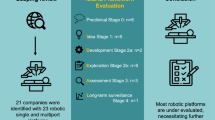Abstract
Background
The role of robotic surgery in bariatrics remains controversial. Patient selection for robotic surgery is not well-studied. The objective of this study was to identify factors associated with robotic surgery and its temporal trends.
Methods
The Metabolic and Bariatric Surgery Accreditation and Quality Improvement Program database from 2015 to 2018 was used. Adult patients undergoing primary sleeve gastrectomy (SG) and Roux-en-Y gastric bypass (RYGB) using the laparoscopic or robotic approach were identified. Revisional, hybrid, or those with concomitant procedures were excluded. Logistic regression was conducted to identify factors associated with undergoing robotic-assisted surgery.
Results
Among 211,568 patients who underwent SG, 9.1% underwent a robotic SG; among 76,805 patients who underwent RYGB, 7.9% of patients underwent a robotic RYGB. During 2015-2018, robotics increased from 7.1 to 11.3% for SG and 7.4 to 8.6% for RYGB. After controlling for patient characteristics, there was still an increasing trend in the use of robotic surgery: SG (multivariable-adjusted odds ratio, aOR, 1.18; 95% confidence interval, CI, 1.17–1.20) and RYGB (aOR, 1.05; 95% CI, 1.03–1.08). For both robotic SG and RYGB, functional status and African American race were associated with undergoing robotic surgery, while races other than White or African American and Hispanic ethnicity were not. Pre-operative IVC filter was associated with robotic SG, while the presence of GERD, diabetes, and COPD were associated with robotic RYGB.
Conclusions
Robotic bariatric surgery has increased over time. Our findings identified factors associated with the receipt of robotic surgery. Reasons for these factors require further investigation to better delineate indications for this technology.
Graphical abstract



Similar content being viewed by others
References
Obesity and overweight. https://www.who.int/news-room/fact-sheets/detail/obesity-and-overweight. Accessed 26 May 2020.
Hales CM, Carroll MD, Fryar CD, Ogden CL. Prevalence of obesity and severe obesity among adults: United States, 2017-2018. https://www.cdc.gov/nchs/data/databriefs/db360-h.pdf. Published February 2020. Accessed July 20, 2020.
Chang S-H, Stoll CRT, Song J, et al. The effectiveness and risks of bariatric surgery: an updated systematic review and meta-analysis, 2003-2012. JAMA Surg. 2014;149(3):275–87. https://doi.org/10.1001/jamasurg.2013.3654.
Weller WE, Rosati C. Comparing outcomes of laparoscopic versus open bariatric surgery. Ann Surg. 2008;248(1):10–5. https://doi.org/10.1097/SLA.0b013e31816d953a.
Ahmad A, Ahmad ZF, Carleton JD, et al. Robotic surgery: current perceptions and the clinical evidence. Surg Endosc. 2017;31(1):255–63. https://doi.org/10.1007/s00464-016-4966-y.
Shepherd JM, Harilingam MR, Hamade A. Ergonomics in laparoscopic surgery--a survey of symptoms and contributing factors. Surg Laparosc Endosc Percutan Tech. 2016;26(1):72–7. https://doi.org/10.1097/SLE.0000000000000231.
Aitchison LP, Cui CK, Arnold A, et al. The ergonomics of laparoscopic surgery in live surgical environments. J Minim Invasive Gynecol. 2015;22(6S):S105. https://doi.org/10.1016/j.jmig.2015.08.283.
Moore LJ, Wilson MR, McGrath JS, et al. Surgeons’ display reduced mental effort and workload while performing robotically assisted surgical tasks, when compared to conventional laparoscopy. Surg Endosc. 2015;29(9):2553–60. https://doi.org/10.1007/s00464-014-3967-y.
Li K, Zou J, Tang J, et al. Robotic versus laparoscopic bariatric surgery: a systematic review and meta-analysis. Obes Surg. 2016;26(12):3031–44. https://doi.org/10.1007/s11695-016-2408-5.
Celio AC, Kasten KR, Schwoerer A, et al. Perioperative safety of laparoscopic versus robotic gastric bypass: a propensity matched analysis of early experience. Surg Obes Relat Dis. 2017;13(11):1847–52. https://doi.org/10.1016/j.soard.2017.07.016.
Papasavas P, Seip RL, Stone A, et al. Robot-assisted sleeve gastrectomy and Roux-en-y gastric bypass: results from the metabolic and bariatric surgery accreditation and quality improvement program data registry. Surg Obes Relat Dis. 2019;15(8):1281–90. https://doi.org/10.1016/j.soard.2019.04.003.
Benizri EI, Renaud M, Reibel N, et al. Perioperative outcomes after totally robotic gastric bypass: a prospective nonrandomized controlled study. Am J Surg. 2013;206(2):145–51. https://doi.org/10.1016/j.amjsurg.2012.07.049.
Stefanidis D, Bailey SB, Kuwada T, et al. Robotic gastric bypass may lead to fewer complications compared with laparoscopy. Surg Endosc. 2018;32(2):610–6. https://doi.org/10.1007/s00464-017-5710-y.
Moon RC, Gutierrez JC, Royall NA, et al. Robotic Roux-en-Y gastric bypass, is it safer than laparoscopic bypass? Obes Surg. 2016;26(5):1016–20. https://doi.org/10.1007/s11695-015-1884-3.
Lundberg PW, Wolfe S, Seaone J, et al. Robotic gastric bypass is getting better: first results from the metabolic and bariatric surgery accreditation and quality improvement program. Surg Obes Relat Dis. 2018;14(9):1240–5. https://doi.org/10.1016/j.soard.2018.05.022.
Sebastian R, Howell MH, Chang K-H, et al. Robot-assisted versus laparoscopic Roux-en-Y gastric bypass and sleeve gastrectomy: a propensity score-matched comparative analysis using the 2015-2016 MBSAQIP database. Surg Endosc. 2019;33(5):1600–12. https://doi.org/10.1007/s00464-018-6422-7.
Gray KD, Pomp A, Dakin G, et al. Perioperative outcomes and anesthetic considerations of robotic bariatric surgery in a propensity-matched cohort of super obese and super-super obese patients. Surg Endosc. 2018;32(12):4867–73. https://doi.org/10.1007/s00464-018-6241-x.
Pastrana M, Stoltzfus J, Claros L, et al. Outcomes of robotic bariatric surgery in super-obese patients: first report based on MBSAQIP database. Surg Obes Relat Dis. 2020;16(1):71–9. https://doi.org/10.1016/j.soard.2019.10.009.
Vossler JD, Pavlosky KK, Murayama SM, et al. Predictors of robotic versus laparoscopic inguinal hernia repair. J Surg Res. 2019;241:247–53. https://doi.org/10.1016/j.jss.2019.03.056.
Kim SP, Boorjian SA, Shah ND, et al. Disparities in access to hospitals with robotic surgery for patients with prostate cancer undergoing radical prostatectomy. J Urol. 2013;189(2):514–20. https://doi.org/10.1016/j.juro.2012.09.033.
Turner M, Adam MA, Sun Z, et al. Insurance status, not race, is associated with use of minimally invasive surgical approach for rectal cancer. Ann Surg. 2017;265(4):774–81. https://doi.org/10.1097/SLA.0000000000001781.
Gabriel E, Thirunavukarasu P, Attwood K, et al. National disparities in minimally invasive surgery for pancreatic tumors. Surg Endosc. 2017;31(1):398–409. https://doi.org/10.1007/s00464-016-4987-6.
Buchs NC, Pugin F, Chassot G, et al. Robot-assisted Roux-en-Y gastric bypass for super obese patients: a comparative study. Obes Surg. 2013;23(3):353–7. https://doi.org/10.1007/s11695-012-0824-8.
Chaar El M, King K, Pastrana M, et al. Outcomes of robotic surgery in revisional bariatric cases: a propensity score-matched analysis of the MBSAQIP registry. J Robot Surg. 2020;370(Suppl4A):2002e2013–5. https://doi.org/10.1007/s11701-020-01098-z.
Gray KD, Moore MD, Elmously A, et al. Perioperative outcomes of laparoscopic and robotic revisional bariatric surgery in a complex patient population. Obes Surg. 2018;28(7):1852–9. https://doi.org/10.1007/s11695-018-3119-x.
Fazl Alizadeh R, Li S, Inaba CS, et al. Robotic versus laparoscopic sleeve gastrectomy: a MBSAQIP analysis. Surg Endosc. 2019;33(3):917–22. https://doi.org/10.1007/s00464-018-6387-6.
Author information
Authors and Affiliations
Corresponding author
Ethics declarations
Conflict of Interest
The authors declare no competing interests.
Additional information
Publisher’s Note
Springer Nature remains neutral with regard to jurisdictional claims in published maps and institutional affiliations.
Rights and permissions
About this article
Cite this article
Dimou, F.M., Ackermann, N., Chang, SH. et al. Understanding the Current Role of Robotic-Assisted Bariatric Surgery. OBES SURG 31, 3130–3137 (2021). https://doi.org/10.1007/s11695-021-05375-0
Received:
Revised:
Accepted:
Published:
Issue Date:
DOI: https://doi.org/10.1007/s11695-021-05375-0




